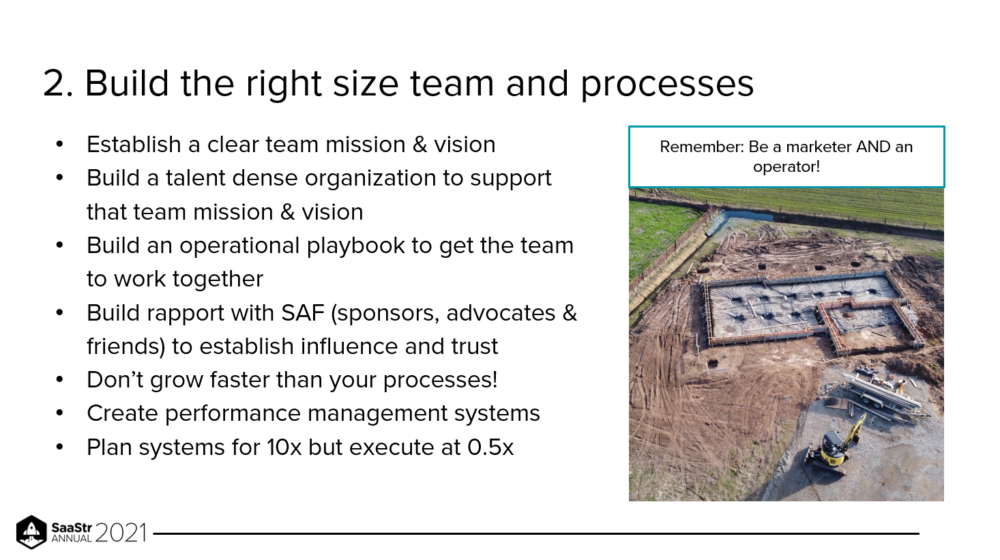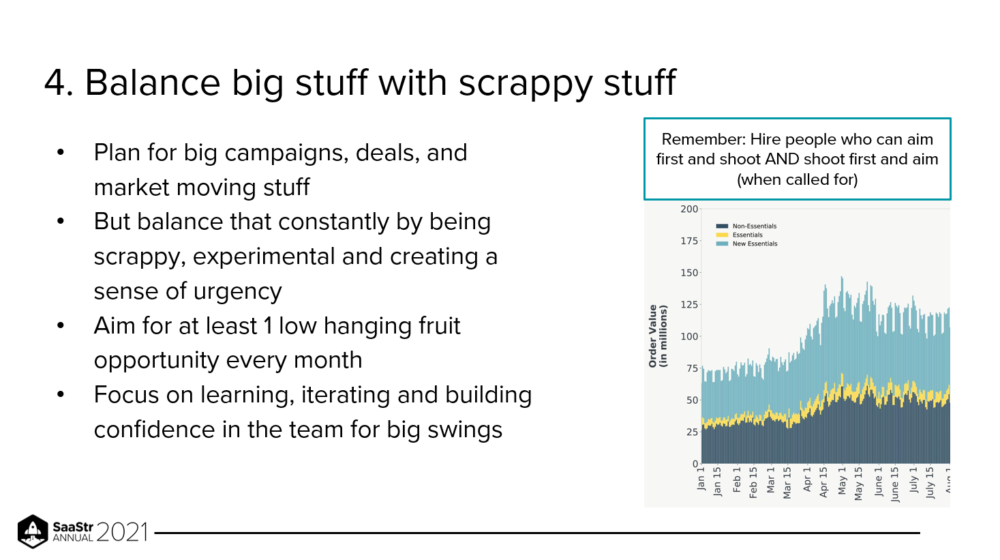Kady Srinivasan calls herself a reluctant marketer. She started her career as an engineer, but eventually found her way into marketing, as many of us do. At first, she was performance-focused, but over time she learned more and more about the value of brand and customer marketing, especially when you’re growing—and growing fast.
As the Head of Marketing at Klayvio, she discusses her experience growing a small, new marketing team to an organized, self-sufficient one all while the company was experiencing hyper-growth at every level. She details her six steps to manage successful marketing at scale.
Step 1: Align with the CEO
As the CMO, you need to understand the company’s founding story and principles to shape the story you put into the market. To do that requires a deep understanding and appreciation of the company’s mission, vision, product strategy, financial plan, and more—all of which you get from communicating with the CEO.
If you have a founder with a large vision, they’re thinking 20 years out with a big, wide-reaching goal. It’s the job of the CMO to bring it down to 1-year, 5-year plans. Distill it down to what we can do now, tomorrow, and a few years from now.
Your job is to communicate the CEO’s vision. The way I accomplish this is through structured one-on-ones and occasional ad-hoc meetings. During our weekly one-on-ones, we discuss business updates and what marketing is doing.
Our ad-hoc, mind-meld sessions are infrequent, but when we have them, they are two to three hours long and we discuss anything that comes to mind or is relevant, like how we think about a specific category or what impact something might have on our business.
Keeping that open line of communication between you and your CEO for all topics is key to successful alignment.
Want more? Enter your email below for the latest SaaStr updates
Step 2: Build the right size team and processes
From the very beginning, establish a clear team mission and vision, and build a talent-dense organization to support that.
My first five hires at Klayvio were the heads of brand, performance, product marketing, self-serve, and analytics operations and research. These strategic functions were able to build an operational playbook and hire the doers underneath them to make the right moves.
No matter what, make sure the team you build is comfortable and works well together. The specific product and industry you can teach—team skills and a go-getter attitude are much harder.
I’ve personally always preferred high EQ over high IQ because that’s what makes strong teams.
Step 3: Be the customer whisperer
Even in product-led companies, you have to do the work to understand the market, your customers, and their attitudes and buyer journeys. Even more importantly, you need to understand your non-customers and rejectors. Why are they not interested in your product? Is there something you can do about it? You won’t be able to find that out without keeping your ear to the ground.
Work with other customer-facing teams to create those rich insights that can benefit your entire organization and customer base.
If I really need to understand customers’ aspirations and figure out how to emotionally resonate with them, I need to understand the brand. That’s when I understood the power of brand and storytelling.
Remember: the people not listening to you are as valuable as the ones who are.
Step 4: Balance big stuff with scrappy stuff
As a CMO, you’ll need to plan for big campaigns, deals, and market-moving stuff.
But don’t forget to balance that by constantly being scrappy and experimental. Aim for at least one low-hanging fruit opportunity a month, and use these opportunities to create a sense of urgency in the market.
You need to focus on learning, iterating, and building your team’s confidence to make an impact with big stuff continuously.
Step 5: Discard your playbook and create a new one
When working on your marketing playbook, focus on the big three: volume, range, and quality of experiments. Create a stacked experiment culture that supports your entire team.
The temptation may be high to simply reuse a playbook that worked flawlessly for you at another company. I challenge you to resist that urge. Your playbook may have worked for you, but what goes well at one company falls flat at another. Draw on your experience selectively and remember that all new category-busting companies will need marketing innovation and agility.
Success is nothing more than a few simple habits practiced regularly.
Step 6: Be prepared for a rollercoaster
As a CMO, everything comes faster than you expect. You’re forming and norming, performing and already outperforming, and doing all of this at the same time, again and again.
Don’t forget to take your foot off the pedal once in a while. Take care of your team’s wellness and health and don’t overwork them. Compassion and accountability can go together in a successful, hyper-growth marketing team. It’s okay to take a break, it’s okay to screw up, and it’s okay to shift your goals and visions halfway through—you’ll get there together!
It’s all an adventure the team is working on together. Hold your goals tightly but your path lightly. The path is always going to change. As long as you hold your goals close to your heart, it doesn’t matter what path you’re going to take—you’ll reach those goals.



